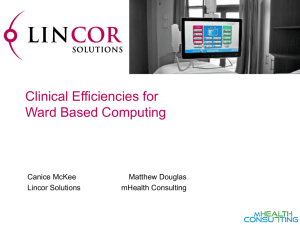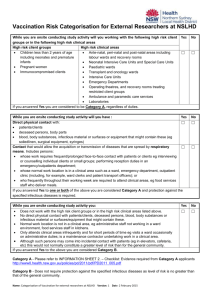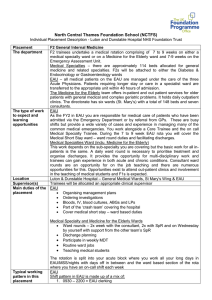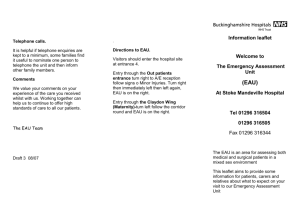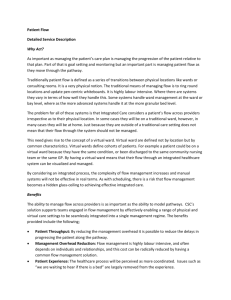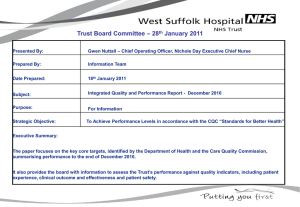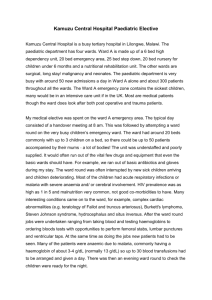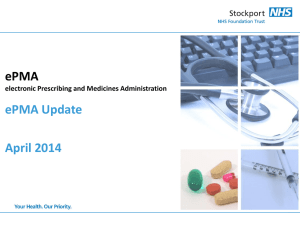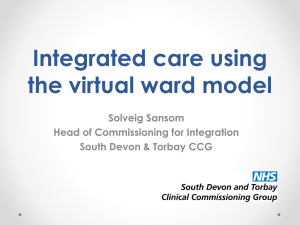The Virtual Ward
advertisement
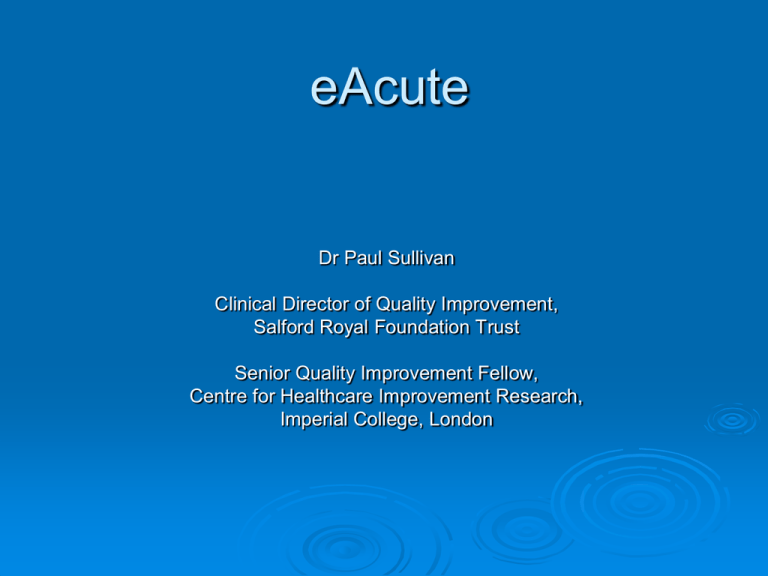
eAcute Dr Paul Sullivan Clinical Director of Quality Improvement, Salford Royal Foundation Trust Senior Quality Improvement Fellow, Centre for Healthcare Improvement Research, Imperial College, London Risks of hospital stay Risk of infection Risk of medical accidents Medication errors Loss of control Discomfort, sleeplessness Disruption Medical Reasons? Treatment only available in hospital Monitoring Risk of rapid deterioration Temporary increase in care needs Survey Daily review of general medical inpatients in a medical ward– 240 bed days Classified into 19 “reasons” 15% of patients did not need to be in hospital Survey of medical wards 23% of medical in-patients “stable” of cases by expert panel – 9.6% could be managed at home Review Of patients delayed for <2 weeks, 43% were due to medic behaviour Survey of medical wards Daily visit to medical wards, each team contacted Able to identify that 15% of in-patients could be managed in virtual ward system Average LOC after identification 10 days Things have moved on since then Delays in diagnostics removed LOS saved likely to be 1-2 days Reasons for delay Waiting for test Waiting for results Waiting for opinion Waiting for senior review Why? apprehensive about discharge – loss to f/u, delay to first OPA Medics Team need to make a decision(s) straight after the next test(s) No knowledge of OP services Is there a better way of managing these patients? Could they be at home? Survey on 28 bed EAU 2006 Could this patient be safely and effectively managed at home Audit on 28 bed AMU Could this patient be safely and effectively managed at home 2-7 patients each day Alternatives Traditional OPD setting has limits Time between available follow up slots Patient “visible” only at clinic visit Availability of diagnostics Time to next FOLLOW UP slot Gen med Cardiology GI Chest 2-11 weeks 17 weeks 8 weeks 7 weeks Alternatives Priority patients can be managed at home by individual clinicians Time consuming, no support, numbers limited Risk of loss to follow up eAcute An electronic patient list to which multiple users can add and which can be seen by all members of the Acute Medicine team. Every weekday at 10am = virtual ward round This is attended by Acute Medicine consultants, mid grades and FY doctors and the advanced practitioner nurse on the EAU. Every patient is discussed every week-day. Junior staff are available to arrange tests, liaise with diagnostic depts etc. If tests are inappropriately delayed we notice immediately and rectify Results are seen immediately and consultant level decisions follow Patients can be reviewed as often as needed by telephone Patients can be recalled to EAU for bloods or clinical assessment We have arrangements with radiology, cardiology and endoscopy so that virtual ward patients are accorded high priority eAcute In-patient Out-patient (Ambulatory) Junior staff available to arrange tests, deliver cards to diagnostics, speak to other services e.g. radiologists No staff available If tests missed for whatever reason (card lost, patient DNA, test postponed) it is immediately spotted and rectified Patient cannot be guaranteed to have test and clinician may not know if test missed If further action is indicated by a test result, it can be taken immediately. Results generally not reviewed until next outpatient appointment Patient has daily review Reviews limited by time between outpatient visits Historically, inpatients have been regarded as more urgent and have tests done quickly. There are often longer waits for outpatient investigations. This is the eAcute ward Ideal for Time-Critical investigation High risk if inadvertent delays High risk if DNA Ideal for Rapid/serial decisions on test results Test 2 depends on test 1 Early/frequent communication with pt Results 160 40 140 35 120 30 100 25 80 20 60 15 40 10 20 5 0 0 Jun Jul Aug Sep Oct Nov Dec Jan Feb Mar Apr May Jun Jul Aug Sep Oct Nov bed days saved patients Results Low Rockall UGI bleed ?VTE Other uss abdo discuss review radiology await result ett pos blood cul monitor bloods ct brain 24h tape rv clinically after we Implementation Not as easy as it seems Critical features Watertight Access – IT solution ideal 24/7, anywhere Embedded in daily work Redundancies – can’t be forgotten I know, with absolute certainty, that if I send a patient home on Sunday, a trusted consultant will pick up the issues on Monday. Critical features Prioritisation Patients are regarded as in-patients by: Radiology Endoscopy Echo, ETT How did we do that? Our story…. Developing IT solution Making it work in the normal day Getting radiology to prioritise Getting other departments to prioritise Sustaining Constant vigilance for fall off in prioritisation Local ownership Keeping Just it team wide add hot water! 4096 bed days in 24 months 5.7 beds free on any day Roll out – estimate additional 5-10 beds 23 minutes per day for 2 consultants and team 50 minutes per day for a JD Transfer Make it watertight – daily case review prevents delays, loss to follow up etc. Timetable daily senior case review so it is guaranteed. Several people need to be involved to ensure that this happens every day, regardless. Develop an electronic patient list that is visible to all members of the team all the time – initial attempts with individual paper lists failed Choose an area with high patient throughput so that there are always some virtual patients to review, otherwise it is difficult to maintain the habit. Start with a single investigation, we used CT pulmonary angiogram, and get clinical directors involved.
